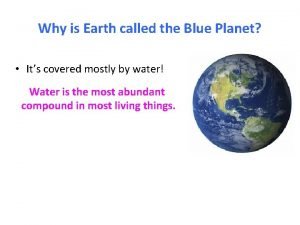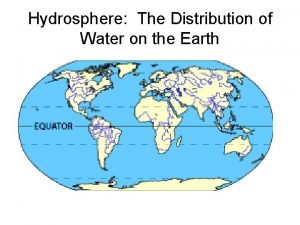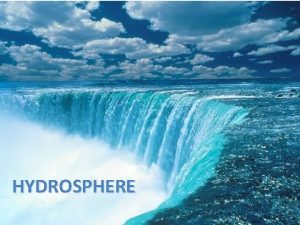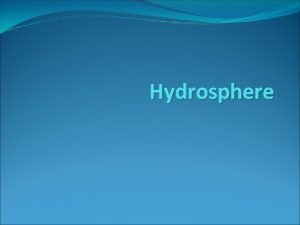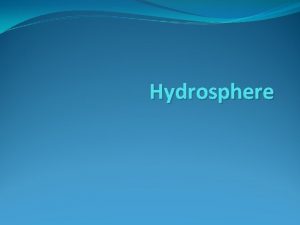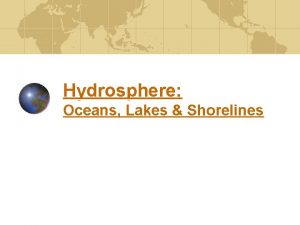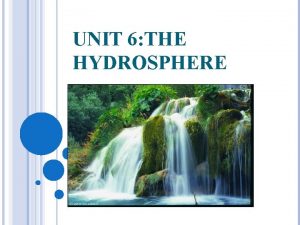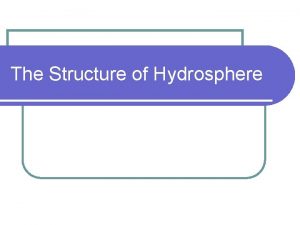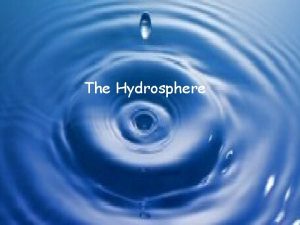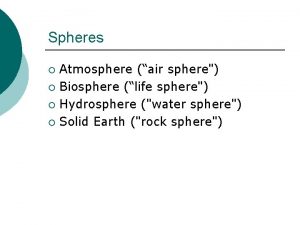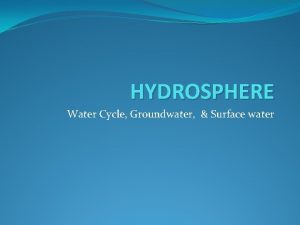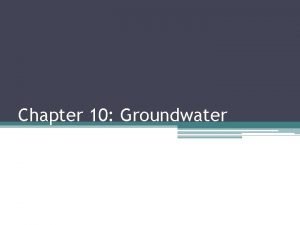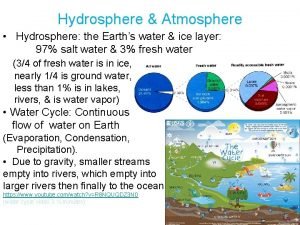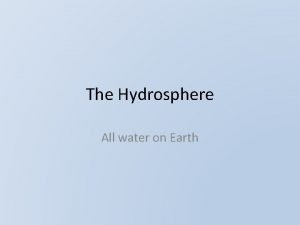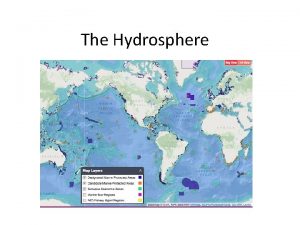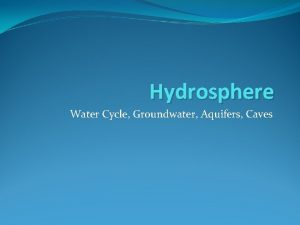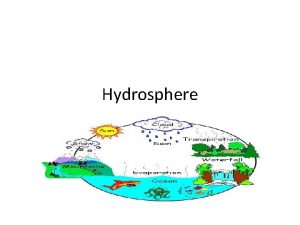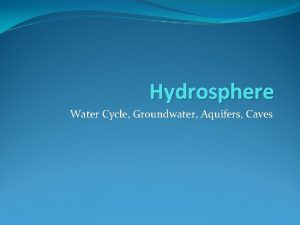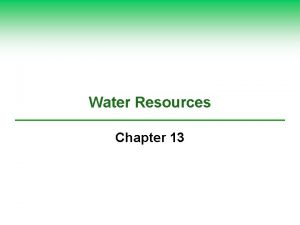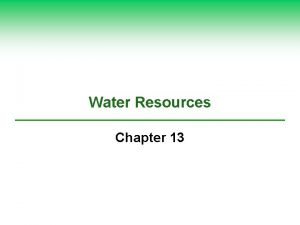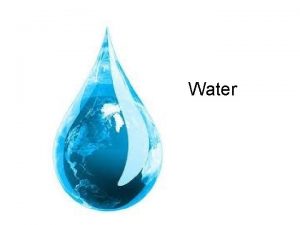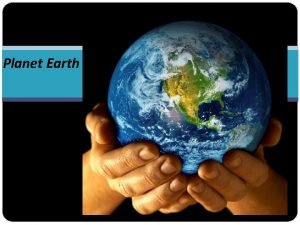HYDROSPHERE Hydrosphere Water Sphere Water of the planet




























- Slides: 28

HYDROSPHERE

Hydrosphere (Water Sphere): Water of the planet 71 % of the Earth’s surface

Distribution of Water World's Water Salt Water Fresh Water 97. 5 % 2. 5 % 79 % 21 % Glaciers Lakes, Rivers, & Groundwater

Inland Waters All freshwater bodies found on continents (includes rivers, lakes, and groundwater)

Inland Watershed (Also known as Catchment area or Drainage basin) basin Area of land in which all inland waters drain into a same larger body of water. The outline of a watershed is defined by natural boundaries (mountains, hills, etc. . . )

Quebec Watersheds 3 major watersheds of Quebec Ungava Bay Watershed Hudson Bay Watershed St. Lawrence River Watershed Each watershed is made up of many smaller watersheds

The Oceans

The Oceans ARCTIC OCEAN PACIFIC OCEAN INDIAN OCEAN SOUTHERN OCEAN ATLANTIC OCEAN

The Oceans Factors that affect Water Temperature

The Oceans Factors that affect Water Temperature: Ø Depth Active layer Thermocline Deep water Solar energy is absorbed near the surface of the ocean. Below a depth of 200 m the temperature drops rapidly; this region is called thermocline.

The Oceans Factors that affect Water Temperature: Ø Latitude

The Oceans Factors that affect Water Temperature: Ø Seasons Surface water temperature will vary from summer to winter.

Ocean Salinity is a measure of the salt concentration in a liquid. Average salinity of most oceans is around 3. 5%, or 35 g/L. (About 10 X higher concentration than in a salt water swimming pool) Salinity is lower near the poles (melting glaciers and pack ice dilute the water) Salinity is higher in regions that are hot and dry (increased evaporation of water)

Ocean Currents The movement of seawater in a certain direction 2 main types of currents: Ø Surface Currents: Mainly wind driven; horizontal. Ø Subsurface Currents: Motion mainly due to differences in density (higher density water will sink). • Higher salinity water is more dense, and will sink below less dense water. • Cold water is generally more dense, and will sink in warmer water.

Ocean Currents

Ocean Circulation The combined effect of all the currents in the oceans Thermohaline Circulation: Circulation Surface and subsurface currents are connected together and circulate around the world.

The Cryosphere The cryosphere consists of all the frozen water on the Earth’s surface Pack Ice: Ice floating on the oceans near the north and south poles. Glaciers: Glaciers Masses of ice on land, formed by compressed snow.

Pack Ice – The North Pole

Melting Pack Ice Melting pack ice threatens the survival of species that depend on the ice. Note: Melting pack ice does not actually raise sea levels; this is because pack ice is already in the ocean.

Melting Glaciers

Melting Glaciers

Iceberg • Large piece of ice that has broken off a glacier • Raises the sea level when it falls into the ocean

Energy Resources in the Hydrosphere Hydroelectricity

Energy Resources in the Hydrosphere Hydroelectricity

Energy Resources in the Hydrosphere Hydroelectricity Beauharnois Power Station Motion Electricity Hydraulic* Energy Electrical Energy * Hydraulic energy (moving water) is a form of kinetic energy

Energy Resources in the Hydrosphere Hydroelectricity Beauharnois Power Station

Energy Resources in the Hydrosphere Tidal Energy Rance Tidal Power Station, France

HYDROSPHERE
 Sphere of control
Sphere of control Why is the earth called the blue
Why is the earth called the blue Water and water and water water
Water and water and water water Hydrosphere images
Hydrosphere images Hình ảnh bộ gõ cơ thể búng tay
Hình ảnh bộ gõ cơ thể búng tay Slidetodoc
Slidetodoc Bổ thể
Bổ thể Tỉ lệ cơ thể trẻ em
Tỉ lệ cơ thể trẻ em Chó sói
Chó sói Thang điểm glasgow
Thang điểm glasgow Chúa yêu trần thế alleluia
Chúa yêu trần thế alleluia Kể tên các môn thể thao
Kể tên các môn thể thao Thế nào là hệ số cao nhất
Thế nào là hệ số cao nhất Các châu lục và đại dương trên thế giới
Các châu lục và đại dương trên thế giới Công của trọng lực
Công của trọng lực Trời xanh đây là của chúng ta thể thơ
Trời xanh đây là của chúng ta thể thơ Mật thư anh em như thể tay chân
Mật thư anh em như thể tay chân 101012 bằng
101012 bằng Phản ứng thế ankan
Phản ứng thế ankan Các châu lục và đại dương trên thế giới
Các châu lục và đại dương trên thế giới Thể thơ truyền thống
Thể thơ truyền thống Quá trình desamine hóa có thể tạo ra
Quá trình desamine hóa có thể tạo ra Một số thể thơ truyền thống
Một số thể thơ truyền thống Bàn tay mà dây bẩn
Bàn tay mà dây bẩn Vẽ hình chiếu vuông góc của vật thể sau
Vẽ hình chiếu vuông góc của vật thể sau Biện pháp chống mỏi cơ
Biện pháp chống mỏi cơ đặc điểm cơ thể của người tối cổ
đặc điểm cơ thể của người tối cổ Ví dụ giọng cùng tên
Ví dụ giọng cùng tên Vẽ hình chiếu đứng bằng cạnh của vật thể
Vẽ hình chiếu đứng bằng cạnh của vật thể

